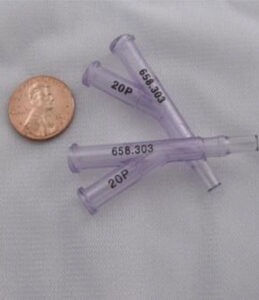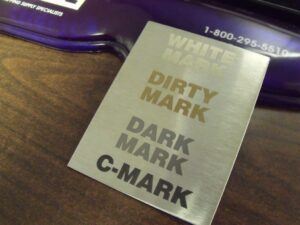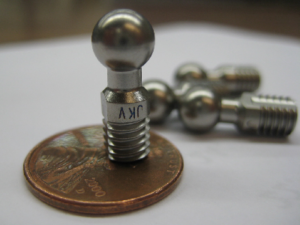In the demanding world of medical devices, precision and reliability are paramount. Every component, from delicate surgical instruments to intricate implants, plays a crucial role in patient care. This extends to the very markings on these parts, which is a service Accumark Inc in Hudson Wisconsin provides.
Why Medical Parts Need Laser Marking:
There are many reasons why medical parts require laser marking. Following are a few reason all of which serve various critical functions:
- Identification and Traceability: Unique Device Identification (UDI) is mandatory for most medical devices. UDI ensures proper tracking throughout the supply chain and facilitating swift product recalls if necessary.
- Part Information: Markings can convey essential details like batch numbers, lot codes, and sterilization dates. These will aid in inventory management and ensuring proper use.
- Instructions and Warnings: Clear markings can provide vital instructions for use, handling, and storage, promoting safe and effective device utilization.

Not All Marking Methods Are Equal:
Some traditional methods like ink printing, chemical etching, or mechanical engraving often fall short. Following are certain examples of suing these techniques:
- Compromise part integrity: They can damage the delicate surface of the part, potentially impacting its mechanical properties and increasing the risk of corrosion or wear.
- Lack permanence: Markings may fade or wear off over time, especially under repeated use or harsh sterilization processes.
- Offer limited flexibility: They may struggle to produce intricate details, logos, or data matrix codes required for UDI compliance.
Fiber Laser Marking Medical Parts:
Enter fiber laser marking, a revolutionary technology that addresses these challenges and offers numerous advantages for medical part marking. Why is fiber laser marking the go method for medical part marking? Here is a list to explain a few common reasons:
- Unmatched Precision: Fiber lasers deliver highly focused beams, enabling the creation of incredibly precise and detailed marks, even on the smallest of components. This is crucial for ensuring the legibility of data matrix codes and other intricate markings.
- Permanent Markings: The laser beam interacts with the material at the atomic level, creating permanent marks that are highly resistant to abrasion, chemicals, and high temperatures. This ensures the information remains clear and legible throughout the device’s lifespan.
- Non-Contact Process: Unlike mechanical methods, fiber laser marking is a non-contact process, eliminating the risk of physical damage or contamination to the part’s surface. This is particularly important for delicate medical components and those requiring a sterile environment.
- Versatility: Fiber lasers can mark a wide range of materials, including stainless steel, titanium, plastics, and even ceramics, making them a highly versatile solution for various medical parts.
- Speed and Efficiency: The process is fast and efficient, allowing for high-volume marking with minimal downtime, contributing to efficient medical device production.

Titanium and Stainless Steel Medical Parts and Fiber Laser Marking:
As has been noted, there are compelling advantages that make fiber laser marking the preferred choice for marking stainless steel and titanium medical parts.
Stainless Steel:
- Corrosion Resistance: Both fiber laser marking and stainless steel boast excellent corrosion resistance. This makes them a perfect match for medical applications where hygiene and biocompatibility are critical.
- Marking Contrast: The laser beam alters the surface of the stainless steel, creating a clear and high-contrast mark that is easily visible.
Titanium:
- Biocompatibility: Titanium is known for its excellent biocompatibility. This makes it a popular choice for implants and other medical devices that come into direct contact with the body. Fiber laser marking does not compromise this biocompatibility, ensuring the safety of the implant.
- Heat Resistance: Titanium has a high melting point. This makes it well-suited for high-temperature sterilization processes that fiber laser marking can withstand without damaging the part.
Therefore, fiber laser marking offers an ideal solution for marking both stainless steel and titanium medical parts, ensuring:
- Clear and permanent identification
- Maintained part integrity and biocompatibility
- Compliance with UDI regulations

Accumark Inc: Your Partner In Medical Part Marking
Located in Hudson, Wisconsin, Accumark Inc is a reputable job shop equipped with several state-of-the-art fiber lasers. Our team of experts leverages these versatile machines to provide high-quality, contract medical part marking services.
Therefore, by partnering with Accumark Inc, medical device manufacturers can benefit from:
- Advanced fiber laser technology: Access to the latest advancements in laser marking for exceptional precision and quality.
- Experienced technicians: Expertise in marking various medical parts, ensuring optimal results and compliance with industry standards.
- Scalable solutions: Ability to handle small or large production runs effectively.
- Commitment to quality: Adherence to strict quality control procedures to guarantee consistent and reliable markings.
In Conclusion
Fiber laser marking has emerged as the gold standard for marking medical parts, particularly those crafted from stainless steel and titanium. Its unmatched precision, permanence, versatility, and compatibility with these materials make it the ideal choice for ensuring clear, reliable, and compliant markings on critical medical devices. If you’re a medical device manufacturer seeking a trusted partner for your marking needs, consider Accumark Inc’s expertise and advanced fiber laser technology to elevate your production process.
Contact Accumark Inc through our contact page with questions and quote requests.
